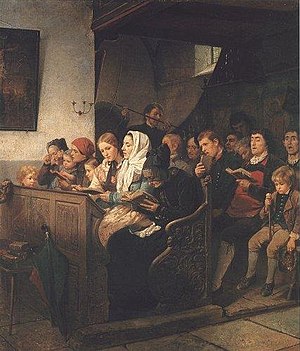Village church with devotees

|
| Village church with devotees |
|---|
| Benjamin Vautier , 1858 |
| Oil on canvas |
| 85 × 73 cm |
| Heylshof |
Village church with worshipers , also worshipers in the village church , is the title of an oil painting by the Swiss painter Benjamin Vautier from 1858 . The picture, which was created in Düsseldorf and is now owned by the Kunsthaus Heylshof in Worms , is in the tradition of narrative genre painting at the Düsseldorf School of Painting .
history
Benjamin Vautier, grew up in Noville ( Canton of Vaud ) as the son of Pastor Rodolphe Benjamin Louis Vautier (1798–1871) and his wife Jeanne Marie Sophie, née. Chevalier, came to the Düsseldorf Art Academy in 1850 , where he was certified as having an "important investment" in Karl Ferdinand Sohn's "painting class" . Because of the requirements of the academy director Wilhelm von Schadow , which seemed to him too narrow , Vautier left the Düsseldorf academy in 1851 and went as a private student to the studio of Rudolf Jordan , who - as a representative of a then innovative movement of the Düsseldorf painting school - was interested in folklore and through intensive studies of nature specialized in underlying genre painting. In Düsseldorf, Vautier made friends with the genre painter Ludwig Knaus . In 1853 they started a journey together with other painters, which led to the Black Forest and the Bernese Oberland , among others . Following Jordan, Vautier began to be interested in customs , such as the details of traditional costumes and the way of life of the rural population. The picture of the village church with worshipers was presented to the public in 1858 in the Eduard Schulte Gallery in Düsseldorf and at the General Art Exhibition in Munich . It brought Vautier a resounding success and established his reputation as a genre painter.
Image description
The image shows a rural parish of the Bernese Oberland in gottesdienstlichem singing and worship . The members of the parish sit, sorted by gender, in the wooden pews of a simple village church , while a clerk leads the bell bag on a pole through the rows. The people depicted represent rural people of the 19th century of different ages , with very different facial expressions , postures and clothing .
interpretation
In the picture, Vautier succeeds in depicting people who depict their individuality and behavior in a “psychologizing” manner. It stands in a tradition of depictions of worship and sermons, which were developed in the 19th century in particular by history and genre painters from the Düsseldorf School. The devotion of the Haugians by Adolph Tidemand (1848, 1852) and the divine service in the prison church by Wilhelm Joseph Heine (1837) are seen as chronologically related and thematically related paintings . Wilhelm Leibl's painting Three Women in the Church (1881) is based on the same motif; in contrast to Vautier, Leibl found a stricter and simpler composition.
Vautier, offspring of a Calvinist rectory , saw the village and peasant community and their individuals in the light of the theology of Johannes Calvin . According to this, only the harmony of the individuals creates the community, only the individual conversion creates the religious community. Church singing has a unifying and god-recognizing function. By depicting different ages of people, from vital childhood to old age with frailty and poor eyesight , the picture is a memento mori and a description of the vanitas motif. It is also part of the multifaceted treatment of the subject of piety , the expectation of salvation and questions about the meaning of life and salvation in European art. The old woman in the center of the picture, dressed as a widow and bent over reading - a well-known motif of iconography in Dutch art of the 17th century - is not only to be interpreted as a representative of a person who is approaching death , but is also the theological center and religious leader of Church to understand as a reference to the prophetess Hanna ( Lk 2,36 EU ), who recognized Jesus Christ as the Messiah in the Jerusalem temple . With the prophetess as a peasant woman, Vautier represents his expectation of the divine in everyday life. Vautier underlined the theological and social statements of his program picture with a motto from the parable of the wise and foolish virgins in the New Testament , which is written in the paneling in the background of the church stands: “Watch and pray because you know (not?) at which hour (d)” ( Mt 25,13 EU ). The concept of society on which the picture is based, which romantically idealizes peasantry, found its model in Jeremias Gotthelf's peasant novel Geld und Geist (1843/1844), which Vautier probably received on the occasion of his study trips to the Bernese Oberland. Figures from the novel can be identified on the painting.
literature
- Georg Swarzenski : The art collection in the Heylshof zu Worms . Catalog, Frankfurt am Main, undated (before 1920), No. 87
- Wend von Kalnein : The Düsseldorf School of Painting . Verlag Philipp von Zabern, Mainz 1979, p. 492 (No. 258)
- Stefan König: Calvinist aspect of salvation and ideal community: Benjamin Vautier's «Devotional in the village church» . In: Art + Architecture in Switzerland (= Art + architecture en Suisse = Arte + architettura in Svizzera) , Volume 45 (1994), Issue 4, pp. 354–360 ( permanent link )
Web links
- Marc Louis Benjamin Vautier, "Village Church with Devout", 1858 , website in the portal deutsche-digitale-bibliothek.de
- Village church with devotees , website in the portal museum-digital.de
Individual evidence
- ↑ Wend von Kalnein , p. 492, dated the picture differently to the year 1856.